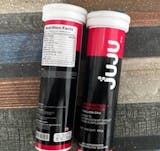One of the best exercises for working all of your major muscle groups at once is the deadlift. It’s fantastic for getting stronger and more powerful, and it may even aid in overall mobility.
For those who enjoy working out and maintaining a healthy body, you probably know firsthand that deadlifting is a great way to build muscle and look beautiful. Learn the benefits of the deadlift, the muscles it targets, variations on the exercise, and more by reading this article!
IN THIS ARTICLE
08. Conclusion
What Is A Deadlift?
A deadlift is an excellent total-body weight-training exercise that targets both the lower and upper extremities. To do a compound exercise, you must use more than one joint and include more than one major muscle group.
In a deadlift, you simply bring a weight from its horizontal resting position to your standing posture. Although the deadlift works a wide variety of muscles, it is most commonly utilized to build up the buttocks, thighs, and back.
Most people do deadlifts with barbells, but if you’re just starting out, it’s important to perfect your form by doing the exercise with no weight at all. You can also use a light body bar, if you have access to one, to simulate barbell lifts without adding excessive weight. Once you have mastered the deadlift using a barbell, dumbbells, kettlebells, or even resistance bands, you are ready to go on to more advanced exercises.
WHAT MUSCLES DOES DEADLIFT WORK
Multiple muscle groups are engaged during a deadlift, making it a complex exercise. Because of their ability to target and develop strength in so many different major muscle groups, deadlifts can be extremely useful. A few of the main muscle groups worked on are:
1. Trapezius
From the skull’s base to the middle of the back, this massive triangle muscle can be found. It helps keep the shoulder blades in place and allows for shoulder blade movement.
2. Glutes
The glutes consist largely of these massive muscles. When performing a deadlift, hip extension is a function of the glutes.
3. Hamstrings
The muscles in the upper back and upper thigh. They help to open up the leg muscles and strengthen the quadriceps.
4. Core
The abdominal muscles and low back muscles make up the core. In tandem, they keep the back from buckling under the strain of a heavy lift. Core muscles, such as the rectus abdominis at the front of your belly, the obliques down the side, and the erector spinae in the back, get a great workout from deadlifts.
5. Hip
Hip extension and flexion are the work of the muscles and ligaments surrounding the hip joint.
6. Lats
The upper and lower back muscles coordinate their efforts to prevent the spine from bending. There are two big, triangular muscles on either side of the spine called the latissimus dorsi (lats). Besides the biceps and triceps, your lats, rhomboids, and traps need to be active when deadlifting for maximum upper-body strength.
Benefits of Deadlift
Get rid of that aching back
Chronic discomfort in the lower back is a very common complaint.
Research suggests that deadlifts can be a helpful technique for lowering or reversing this disease for those with modest mechanical low back pain, although there are many reasons of lower back pain and different therapies are needed for everyone.
Take note that deadlifting with a braced, neutral spine is essential to avoiding further worsening your injury. If you’re suffering from lower back problems, you should talk to a doctor before starting a deadlifting program on your own.
Bone density
Bones benefit from the deadlift because it places a healthy stress on them, which can build bone density and decrease the likelihood of damage. Deadlifts and other forms of resistance training are especially beneficial to bone health as people age.
Posture
You can improve your posture by practicing with the deadlift. Strengthening your back and shoulders combined is a goal of the deadlift. Because of this, your posture may improve.
Muscle Building
A strong upper and lower body can be built with the help of the deadlift. In this way, it contributes to enhanced physical prowess and general strength. Building muscle has been shown to speed your metabolic rate.
Raise your metabolic rate.
Many exercise plans focus on weight loss as their primary objective. Burning more calories than you ingest over a specific time period is essential for weight loss success, especially when your goal is to reduce body fat percentage.
Regular exercise and a reduced calorie diet go hand in hand in the conventional approach to losing weight.
Studies suggest that weight training with movements like the deadlift may be among the most effective ways to improve calorie burn while spending less total time training at the gym.
Furthermore, the increased muscular mass will increase your resting metabolic rate.
Completely Exercise for your Body
A common misconception is that deadlifts only strengthen the lower body. When you perform a deadlift, you’re working your lower and upper back muscles to stabilize your torso as you pull the weight off the floor. Your shoulders will be working very hard to hold your arms locked in place, and your biceps will be stretched to support your arms during the pull.
Beginner Tips In Performing Deadlifts
The deadlift is a powerful exercise that, when performed correctly, may yield incredible results. However, it might cause more harm than help if practiced incorrectly, especially those who are practicing in their home gym . Therefore, it’s crucial that you focus on proper posture and adhere to the instructions below.
A deadlift has three phases: the setup, pull, and lockout.
The setup: If you want to look your best, spread your feet about hip-width apart when you stand. For optimal results, they need to activate their core and squeeze their shoulder blades together and down to work their lats. The barbell should be placed such that it is level with the user’s shins while he or she is seated. The next step is to hinge at the hips, keeping the spine long and the chest up. A palm-up over-under grip is used to lift the barbell. Tighten your grip on the bar and let your hips drop.
The pull: Lift your chest and shoulders off the ground, while also extending your legs and pushing your feet firmly into the floor. You should jut out your hips and draw your knees back.
The lockout: At the top of the motion, keep your shoulders pulled back and your back straight. After pausing, slowly descend the barbell by extending the hips and contracting the thigh and core muscles.
If you’re just starting off with this type of exercise routine. To get the most out of your workout, seeing a coach or trainer is highly recommended. Performing this at home increases the danger of injury, so it is recommended that you watch a tutorial video on YouTube, Tiktok, or another fitness channel to learn the correct form.
Common Deadlift Mistakes
Ignoring proper warmup procedures
One of the most typical mistakes is proper warming up, which occurs well before the actual deadlift is done. Getting ready to deadlift requires more than just a few minutes of cardio on the treadmill.
In addition to strengthening the muscles that will be used in the deadlift, you should undertake mobility exercises and muscle activation drills. This is a typical rookie error that leads to risk of injury during the deadlift.
Slipping your grip on the bar
When you’re ready, how do you really grasp the bar? Set your feet where they need to be, then hold the bar with your hands slightly wider than your hips. A little bit more than two or three millimeters wider than your hips. To complete the exercise properly, your hands need to be this far apart.
Poor hip alignment
This error can occur when the hips are either too high or too low.
If you want to deadlift properly, where should your hips be?
It’s best to start with a tiny bend in your knees and keep them from being entirely straight during the entire workout. Push with your legs once you’re in the right spot.
However, you shouldn’t squat-down too far because you’re not actually doing squats.
Bending the back
Many people round their lower backs when they deadlift, creating an unhealthy curvature that should be avoided at all costs. Avoiding this error should be simple. Of course, you should stay away from it so you don’t have to deal with the discomfort or get hurt.
It’s important to keep your chest up and your back straight when you grab the barbell. If you’re just starting out, this may feel like a strange adjustment that’s impossible to make.
Furthermore, you should try to lift the bar with the strength of your legs rather than your back. As a mental signal to encourage you to utilize your legs more, try to imagine that you are pressing the floor down with your feet.
Incorrect foot position
It’s possible that the location of your feet has never crossed your mind before, but they play a crucial role in a proper deadlift.
Many people experience soreness in their lower backs because they are positioned too far back when performing this exercise, which causes an overload on the lower back when trying to lift the bar off the ground. As a result, the front half of each foot should be tucked beneath the bar so that the entire foot can rest evenly. The correct foot placement is hip-width apart.
Variations of Deadlifts
Changing the deadlift variant you’re using after 4-8 weeks can be advantageous for maintaining gains over the long run.
Here are some alternatives to the standard deadlift that you could try.
Single-leg Deadlift
Relying on one leg to pull the weight off the ground challenges your knee stability, core stability, hip stability, and balance, so while you won’t be able to lift as much weight, you’ll be able to improve your athletic performances. For this routine, you can use a kettlebell, barbell, or dumbbell. However, a kettlebell or dumbbell is a better choice for novices when beginning this exercise.
Conventional Deadlift
For most people, the “deadlift” is the first thing that comes to mind. They are standing with their feet somewhat wider than shoulder-width apart and their arms hanging loosely at their sides. When the trunk is hunched forward, the lower back must bear the brunt of the body’s weight.
Romanian deadlift
The hamstrings and other back muscles receive a good workout with this common version. For this exercise, bending the knees is avoided in favor of keeping the legs reasonably straight.
Electrical measures of muscle activation have shown that the gluteus maximus is similarly activated during the barbell hip thrust and the Romanian deadlift.
In comparison to a back squat, whose pattern is more akin to that of the conventional deadlift, the Romanian deadlift and barbell hip thrust both resulted in much more activation of the gluteus maximus.
That’s why the Romanian deadlift is such a fantastic approach to boost your training for your gluteus maximus.
Barbell hex deadlift
When performing a hex bar deadlift, you stand within the hexagon with the bar’s handles parallel to your body, as if you were holding a suitcase. Hexagons with protruding sleeves in the usual type can have plates attached to them.
When using a hex bar for a deadlift, your hands can be in a more relaxed position, and the weight can be lifted in a straight line with the rest of your body.
Research indicates that more total weight may be lifted when performing hex bar deadlifts, which may lead to higher gains in strength and power due to the increased resistance.
Sumo deadlift
When performing the Sumo deadlift, your feet should be turned outward at an angle of 45 degrees or more from each other. This causes the inner thigh muscles to become more active, which can provide some athletes an advantage.
In instance, studies show that athletes with longer torsos benefit from performing Sumo deadlifts since they allow them to lift more overall weight.
Deficit deadlift
The deficit deadlift involves standing on a slightly elevated platform, usually between 4 and 8 inches (10 and 20 cm) above the barbell’s resting position.
The barbell is lowered in relation to the shins, which provides for a broader range of motion while still training the same muscles as the standard deadlift.
Deficit deadlifts have been shown to enhance the strength balance between the hamstrings and quadricep complex, which could reduce the risk of hamstring injury.
Frequently Asked Questions
Are there any exercises that complement deadlifts in a workout routine?
You can maximize the benefits of your deadlift training by combining it with another complex lift, such as the pull-up, squat, or lunge.
What exercise works the same muscles as deadlift?
Deadlift Alternatives to Consider
- Glute bridge.
- Barbell hip thrust.
- Lying hamstring curl with band.
- Trap bar deadlift.
- Single-leg Romanian deadlift.
- Back hyperextension.
- Cable pull through.
- Bulgarian split squat.
How does deadlifting impact overall strength and muscle development?
Several studies have shown that deadlifts have positive impacts on strength development. They aid in the development of core strength, the improvement of hip stability and mobility, the strengthening of the grip, and the enhancement of body definition by targeting major muscular groups such as the quadriceps, glutes, and abdominals.
How can I incorporate deadlifts into my current workout routine?
Deadlifts are best performed towards the end of a workout, when more volume and repetitions can be put into them. Reasoning behind this tactic is exhaustion on both a neurological and bodily level. If you disregard this safety information, your workout will be less efficient and you may end up with an injury.
Conclusion
The deadlift is one of the best exercises for increasing muscular mass. Your hamstring, hip, and back muscles will all benefit, making it a fantastic addition to any weight training program. Moreover, it is a functional workout, meaning that it helps you build strength while also replicating movements you could encounter in your daily life. When performed properly, deadlifts are among the most effective exercises for gaining muscular mass despite their difficulty. As a complex movement (one that engages more than one muscle group during the course of a single repetition), deadlifts are frequently performed at the start of a training program.
The deadlift is an excellent option for anyone who wants to bulk up. It’s surprising how few people engage in this action, given the many benefits it offers for muscular development. It’s usually down to individual preference or some sort of physiological necessity. Furthermore, due to the seriousness of this workout, it is highly recommended that you seek the advice of professionals at all times.










